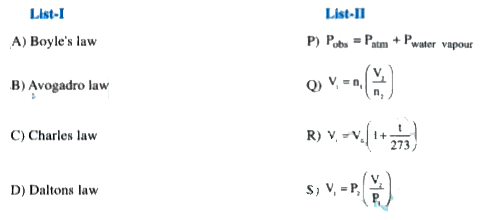For one mole of an ideal gas, if P = P01+(VV0)2 , where P0 and V0 are constants. Which of the following are true?Solution in Telugu
(a)P=P_(0)//2whenV= V_(0)
(b)V= 2V_(0)whenP = P_(0)
(c)T = P_(0)V_(0)//2RwhenV = V_(0)
(d)R = P/(TV_(0))whenP =P_(0)
The correct Answer is:A, C
Step by step video, text & image solution for For one mole of an ideal gas, if P = P_(0)/(1+(V/V_(0))^(2)) , where P_(0) and V_(0) are constants. Which of the following are true? by Chemistry experts to help you in doubts & scoring excellent marks in Class 12 exams.
Updated on:21/07/2023Topper's Solved these Questions
- STATES OF MATTER BOOK - AAKASH SERIESCHAPTER - STATES OF MATTER EXERCISE - LECTURE SHEET (EXERCISE-I) (LINKED COMPREHENSION TYPE QUESTIONS) Passage-I
5 Videos
- STATES OF MATTER BOOK - AAKASH SERIESCHAPTER - STATES OF MATTER EXERCISE - LECTURE SHEET (EXERCISE-I) (MATRIX MATCHING TYPE QUESTIONS)
2 Videos
- SOLUTIONS BOOK - AAKASH SERIESCHAPTER - SOLUTIONS EXERCISE - Objective Exercise -4
50 Videos
- STOICHIOMETRYBOOK - AAKASH SERIESCHAPTER - STOICHIOMETRYEXERCISE - PRACTICE SHEET (ADVANCED) (INTEGER TYPE QUESTION)
2 Videos
Similar Questions
Variation of volume with temperature was first studied by French chemist, Jacques Charles, in 1787 and then extended by another French chemist Joseph Gay-Lussac in 1802. For a fixed mass of a gas under isobaric condition, variation of volume V with temperature t°C is given by V = V0[l+αt] where V0 is the volume at 0°C, at constant pressure.
1 or every 1° change in temperature, the volume of the gas changes by............... of the volume at 0∘ C
View Solution
View SolutionAssertion : Molarity of a solution decreases with an increase of temperature
Reason : As temperature increases volume of the solution increases.
View SolutionAmmonia is oxised by oxygen to give nitric oxide and water. The weight of water produced per gram of nitric oxide is 0.1×xg. What is value of d.
View SolutionOne mole of an ideal gas undergoes a process
p=p01+(VV0)2
where p0and V0 are constants. Find temperature of the gaas when V=V0.
View SolutionPressure of an ideal gas is given by P=P_(0)=[1-(1)/(2)((V_(0))/(V))^(2)]
View SolutionPressure of 1 mole ideal is given by P=P_(0)[1-(1)/(2)(V_(0)/(V))^(2)]
View SolutionOne mole of a diatomic gas undergoes a process P=P0/[1+(V/V30)] where P0 and V0 are constant. The translational kinetic energy of the gas when V=V0 is given by
View SolutionOne mole of an ideal gas undergoes a process P=P0[1+(2V0V)2]−1, where P0V0 are constants. Change in temperature of the gas when volume is changed from V=V0→V=2V0 is:
View SolutionFor one mole of ideal gas if P=(P_(0))/(1+((V)/(V_(0)))) where P_(0) and V_(0) are constant, then temperature of gas when V=V_(0) is:
View SolutionOne mole of an ideal gas undergoes a process p=(p_(0))/(1+((V_(0))/(V))^(2)) . Here, p_(0) and V_(0) are constants. Change in temperature of the gas when volume is changed from V=V_(0) to V=2V_(0) is
View Solutionएक आदर्श गैस का एक मोल ऐसे प्रक्रम से गुजरता है, जिसमे दाब तथा आयतन सूत्र p=p0[1−12(V0V)2] से सम्बंधित है। यहाँ, p0 तथा V0 नियतांक है। यदि गैस का आयतन V0 से बढ़कर 2V0 होता है, तो इसके तापमान का बदलाव होगा
View SolutionOne mole of an ideal gas undergoes a process
p=p01+(VV0)2
where p0and V0 are constants. Find temperature of the gaas when V=V0.
View SolutionPressure of 1 mole ideal is given by
P=P0[1−12(V0V)2] V0 to 2V0. Find change in temperature.
View SolutionOne mole of an ideal gas undergoes a process p=(p_(0))/(1+((V_(0))/(V))^(2)) . Here, p_(0) and V_(0) are constants. Change in temperature of the gas when volume is changed from V=V_(0) to V=2V_(0) is
View Solution
